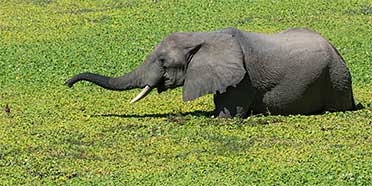
Philip is an acclaimed travel writer and author of many guidebooks, including the Bradt guides to Uganda, Tanzania, Kenya and South Africa.
14 people found this review helpful.
Adventurer’s Africa
One of my top five experiences in more than 30 years of African travel was a canoe safari in Zambia’s Lower Zambezi National Park. This is a total wilderness experience, offering the exhilarating immediacy of being right there, in the bush, on the river, without an engine in earshot or window frame in sight. On the way, we frequently paddled past hippos, crocodiles and a wonderful selection of waterbirds, but we also encountered plenty of elephants and buffalo, and even a lion pride on the bank.
Adventure safaris are a big thing in Zambia. In South and North Luangwa National Parks, for instance, many camps and lodges specialise in guided walks through a vast stretch of wilderness where close encounters with buffalo, leopard, lion and elephant are an everyday occurrence. The same goes for the immense Kafue – Africa’s largest national park – where highlights include boat trips along a forested stretch of river alive with hippos and elephants.
Thanks partly to Zambia’s exceptionally high standards of guiding, the country’s finest reserves seem to offer a fuller and richer Africa than the one you see from the security of a vehicle. Whether you’re on foot or in a canoe, the zebras look bigger, the giraffes tower higher, and faced by the cold stare of a buffalo or warning trumpeting of an elephant, your vulnerability and sense of being an intruder in the bush is painfully, thrillingly manifest.
In addition to Luangwa, Kafue and Lower Zambezi, Zambia boasts a number of very worthwhile but lesser-known parks. Foremost among these is Liuwa Plain, where on a recent visit we caught Africa’s second-largest wildebeest migration on the move, and also had exceptional lion and spotted-hyena sightings. Kasanka National Park is famed for a fruit bat migration comprising up to 12 million individuals, and it’s the only place I’ve been in southern Africa where the localised sitatunga antelope is easily observed and photographed.
Zambia is easily underestimated as a birding destination. Blue Lagoon and Lochinvar National Parks on the Kafue Flats protect extensive wetlands alive with aquatic birds, many not easily seen elsewhere in southern Africa, but the prime attraction for most birders are the Bangweulu Wetlands, which protect the world’s most southerly population of the spectacular shoebill.

Ariadne is a renowned African wildlife photographer whose work is featured in many well-known guidebooks and magazines.
12 people found this review helpful.
Quality safaris in untrammeled wilderness
Zambia’s safari industry is run by people with a passion for the bush and conservation. Safaris aren’t mainstream here; everything is tailor-made. Lodges are usually rustic, intimate affairs, and very often owner-run. I’ve come to appreciate a very high standard of guiding in Zambia. This makes the country ideal for repeat visitors who’ve already ticked off the Big Five and are looking for a more in-depth experience. I also love the variety of activities offered; mixing walking and boating with game drives makes for a perfectly balanced safari experience. The Zambezi, Luangwa and Kafue Rivers offer excellent opportunities for river safaris. A highlight for me was a canoe safari in Lower Zambezi National Park. I’ll never forget gliding silently through the channels enjoying the birdlife with hippos grunting all around me. There were some hair-raising moments: when an elephant herd crossed the water in front of me and when only 2m of shallow water separated me from some very inquisitive looking lions. My highly qualified guide made me feel totally safe though. South Luangwa and the untrammeled wilderness of Kafue are other top safari destinations not to be missed. Beyond this trio of top-notch parks are lots of lesser-known safari gems. Highlights on my recent trip were being surrounded by the wildebeest migration in Liuwa Plain, looking for shoebills in the Bangweulu wetlands and watching millions of bats at sunset in Kasanka.

Brian is an award winning travel writer, author of safari books and regular contributor to magazines such as BBC Wildlife and Travel Africa.
1 person found this review helpful.
Africa the way it used to be
This vast and landlocked corner of Africa is best visited in the dry season between June and October. With neighbouring Zimbabwe it shares the rich wildlife of the Zambezi Valley and the awesome spectacle of the Victoria Falls, which Zambians call by a more colourful name: Mosi oa Tunya - the Smoke that Thunders.
Zambia’s finest big game viewing is to be found in the North and South Luangwa national parks where the meandering Luangwa River provides permanent water for a host of animals including all the Big Five. Both parks offer unrivalled walking safaris with top-notch guides and a reputation for small and comfortable owner-run camps.
Zambia’s biggest park, Kafue, is another must-see safari destination, and although it takes second place in popularity to South Luangwa it is utterly wild and untouched.
To spend a few days here looking for lions in the endless grasslands of the Busanga Plains is to experience the true spirit of Africa as it used to be.
In addition Zambia has more than a dozen other lesser-known parks, ranging from the remote Liuwa Plains to Kasanka’s miombo woodlands and the Bangweulu wetlands with their shoebill storks and herds of black lechwe antelope.

Harriet is a zoologist with more than 20 years’ experience. She has the privilege of working with the world’s top wildlife photographers and photo-guides.
Africa for Safari Aficionados
Zambia is huge, with a wide variety of wildlife destinations, and far less tourism than the other better-known safari countries. This for me is what makes Zambia so special. Roads and other infrastructure are steadily improving, with an increasing number of high-end lodge offerings and small specialist camps, as well as the chance to really get off the beaten track.
Zambia’s jewel in the crown is South Luangwa National Park, rich in wildlife, including good numbers of predators (excluding cheetah). Kafue National Park is a sleeping giant with huge potential, while Lower Zambezi National Park is spectacularly beautiful. Zambia also has a number of specialist destinations, including the chance of seeing shoebills in Bangweulu Wetlands, the awe-inspiring bat migration in November in Kasanka National Park and the second-largest gathering of wildebeest, also in November, in Liuwa Plain National Park in the west. Victoria Falls in Livingstone is one of the most famous African destinations, but Zambia has a whole host of other dramatic but little-known waterfalls just waiting to be explored.
As well as game drives, walking safaris were pioneered in Zambia, and you also have the opportunity for canoeing trips on the Zambezi River. Zambia really does offer a wide range of wild adventures.

Dale is a multi-award-winning writer and photographer with more than 500 published magazine articles featured in magazines such as National Geographic, BBC Wildlife, Travel Africa, and CNN Travel.
A World of Adventure and Natural Splendour
“The hooded vulture is a very good indicator of the near presence of predators,” my experienced bush-hiking guide told me as we observed several large birds descending into the thick brush ahead.
We were in the beautiful game-rich South Luangwa National Park, on a multiday on-foot camping safari.
“They enjoy eating lion poop,” she added. “So, let’s go take a closer look.”
Much to my astonishment, we advanced rather than retreated, and before long, I found myself crouching behind a termite mound, watching a lazy pride of lions at around 50m distance. They were clearly aware of our presence.
At first, I was nervous, but my guide pointed out that the cats were relaxed, and eventually, my heart rate normalised allowing me to truly enjoy the thrill of it all.
Zambia is a wonderful country full of exhilarating adventures to enjoy.
I have visited in the ‘Emerald’ season when the great Zambezi River bursts its banks (as it does each year) and explored South Luangwa by boat rather than in a safari vehicle. I have gone on horseback safaris in Kafue National Park. I have paddled through the Bangweulu Wetlands in search of the weird and wonderful shoebill, and I have gone to Kasanka and seen the sunset sky turn black with a blizzard of fruit bats, some of whom pooped on me.
Ever wanted to go fishing on the Zambezi River? Stand in awe at the tumultuous cascades of Victoria Falls? Canoe and camp surrounded by elephants and hippos?
It’s all on the menu in Zambia.
There are some 20 national parks, including iconic destinations such as North and South Luangwa, Lower Zambezi and Kafue to get your big game fix. But some of the lesser-known parks are just as fantastic.
My personal favourite has to be the Liuwa Plain, an amazing place with endless horizons and excellent wildlife viewing. It used to be almost empty (due to poaching), but thanks to the long-term and ongoing work of African Parks (a conservation organisation), the place is now teeming with animals, lions, hyenas and painted wolves among them.

Lizzie is a reputed guidebook writer and author of the Footprint guides to South Africa, Namibia, Kenya, Tanzania, Uganda and Zimbabwe.
Varied wildlife, mighty rivers, and an excellent choice of safari activities.
Zambia has got a lot to offer in the way of habitats, from meandering river flood plains to ancient savannah woodland; all of which harbour a great diversity of species. It’s not a place where you’re going to trip over the Big 5 in an afternoon’s safari – although they are all present – but each park is quite splendidly different scenically and offers unique wildlife encounters.
South Luangwa is the most visited (and has the largest choice of lodges and camps) and is the best place to see buffalo, leopard, lion and elephant. I’ve had many a memorable evening sitting on the deck of a lodge or at a campsite watching the activity on the sludgy brown Luangwa River – the constant procession of elephants coming down to drink, impala flitting across the sandbanks and ever-watchful crocs basking in the shallows. The Lower Zambezi National Park too is a good place to see the larger species, again attracted by a magnificent life-giving river. Here the best vantage point is undoubtedly from a canoe – silently watching the animals drink their fill from mere metres away is exhilarating.
For a long time Zambia was often perceived as under the radar or ‘untouched’ as a mass safari destination. While in places the industry has flourished tremendously in recent years, its success has sensitively progressed too – expertly-guided walking safaris are a fine less-obtrusive option to pop-up minibuses, while small bush camps and rustic river lodges make the most of their spectacular environments without spoiling them. And, while they receive very few visitors and have little infrastructure, there are still some quiet corners of Zambia to be explored. I’ve had some wonderful encounters with rhino, honey badger and wild dog on the remote and hard-to-get-to floodplains in North Luangwa, while watching the unfathomable and dramatic migration of hundreds of thousands of fruit bats in Kasanka National Park’s magical forests was nothing short of extraordinary.







